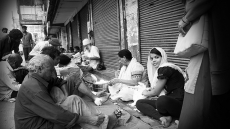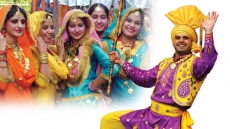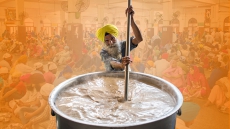The harvest festival is characterized by the folk dance of bhangra, a perfect form of expressing the joy, celebration, and thanking the supreme above.
Vaisakhi, foundation day of the Khalsa Panth, harvesting of crops, and new hopes with the beginning of a new year, is a day of celebrating the colour saffron. As the entire Punjabi community believes in celebrating this auspicious day with colours, bhangra, and makke di roti te sarso da saag, it is popularly seen as a celebration of culture. Vaisakhi being one of the important festivals of Punjabi culture, it would not be wrong to call it as the ‘Thanksgiving of Punjabis.’
The colourful festival is the day of reaping crops and binding huge hopes with it. It is the day when farmers, after months of diligence, are ready to reap their hard-earned money. It is the day when they celebrate and give thanks for what they have earned. In the history of Sikhism, Vaisakhi has a prominent value as being the day of Khalsa Foundation by the 10th Sikh Guru, Guru Gobind Singh, when he baptised his first Five Beloved (Panj Pyare) and later got baptised from them. This laid the foundation of Khalsa Panth – the main two places of celebration being Sri Anandpur Sahib and Talwandi Sabo.

In Punjab and in major parts of India and across the world, the day of Vaisakhi is marked by organizing the ‘Nagar Kirtan’ where Sikh communities organize processions, led by the Panj Pyares, and people march along, chanting hymns from the Sikh texts in the presence of Guru Granth Sahib in reverence, and free langar to all attendees is given at the occasion.
The harvest festival is characterized by the folk dance of bhangra, a perfect form of expressing the joy, celebration, and thanking the supreme above. It is the most appropriate form of expressing happiness for Punjabis. As the Punjabi community began to spread wide across countries, it became all the more important to promote and revive the Punjabi culture, art and folk. Canada-based Surrey India Arts Club (SIAC) opened its doors around April 1975 with an idea of floating an institution that will promote and preserve Punjabi folk dances, culture and language across North America. Arts, and most importantly through bhangra, SIAC has taken the initiative to protect the culture. In recent years, SIAC was the first team in Canada to dance bhangra at a Vaisakhi event at Parliament Hill, Ottawa. Additionally, SIAC has performed in numerous Nagar Kirtans both in and outside Vancouver.

The alumni of SIAC hold important positions in the society – Punjabi singer Sarbjit Cheema; Kulwinder Sanghera, president of South Asian Broadcasting (93.1 Red FM); Sahib Singh Thind, president of Prof. Mohan Singh Memorial Foundation (Mela Gadri Babian Da); Punjabi singer Gary Hothi; Tejinder Singh, director of Akash Broadcasting (91.5 FM). Since its existence, SIAC has always stepped in to bring up the talents and promote the culture at numerous areas of opportunities. Members of the organization understand that “change is law of nature.” Culture is not a snapshot in time and should never be looked upon as a static picture. Culture is something that is directly related with people.
Whenever there is a wave of change among masses, there is a direct impact on culture. Traditions change over time. What matters at Surrey India Arts Club is not the change itself but seeing that the change is for the good and positive growth of community and our traditions. Dedicatedly working hard, every member at SIAC tries to ensure that with change, people do not forget or loose the best part of their excellent traditions – especially in the field of folk dances of Punjab namely bhangra, gidha, malwai giddha, jhumar and dhamal. Additionally, the focus is always on encouraging the participation of youth in folk songs and learning different folk music instruments of Punjab.



